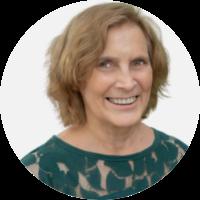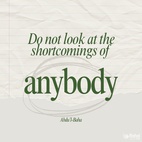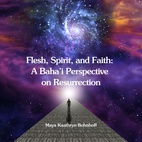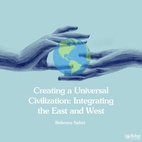The views expressed in our content reflect individual perspectives and do not represent the authoritative views of the Baha'i Faith.
In my college courses about media analysis, when I taught my students how to analyze the symbols used in media images, I asked them to figure out the values represented in any particular image.
For one exercise, I’d share a photo I took of a local intersection of two six-lane streets. On the corners the image shows buildings made of cinderblock housing a gas station, two drive-through banks and an auto parts store, each with oversized brightly colored signs. Also visible are concrete sidewalks, asphalt parking lots and sentinel traffic lights. The photo includes no greenery, no shade and no foot traffic.
RELATED: The Spiritual Meaning and Significance of the Number 9
I hoped that my students would observe how people were isolated in their cars, and likely communicating with horns, turn signals, and the occasional finger. I’d ask if they saw any beauty or signs of community. Then I’d ask, how did the image make them feel: Loving? Peaceful? Alienated?
Two Kinds of Knowledge: Sensible and Symbolic
The Baha’i teachings point out that human beings can access two kinds of knowledge: sensible and symbolic:
One is the knowledge acquired through the senses. That which the eye, the ear, or the senses of smell, taste, or touch can perceive is called “sensible.” …
The other kind of human knowledge is that of intelligible things; that is, it consists of intelligible realities which have no outward form or place and which are not sensible. For example, the power of the mind is not sensible, nor are any of the human attributes: These are intelligible realities. Love, likewise, is an intelligible and not a sensible reality. … Likewise, nature itself is an intelligible and not a sensible reality; the human spirit is an intelligible and not a sensible reality.
But when you undertake to express these intelligible realities, you have no recourse but to cast them in the mould of the sensible, for outwardly there is nothing beyond the sensible.
In the holy scriptures of every Faith, symbols abound. We get in trouble when we read those scriptures literally, because their symbolic meanings transcend sensible interpretations. Abdu’l-Baha, the son and successor of Baha’u’llah, who founded the Baha’i Faith, addressed this question in a talk he gave in New York in 1912:
The divine Words are not to be taken according to their outer sense. They are symbolical and contain realities of spiritual meaning. For instance, in the book of Solomon’s songs you will read about the bride and bridegroom. It is evident that the physical bride and bridegroom are not intended. Obviously, these are symbols conveying a hidden and inner significance.
We live much of our lives through symbols, even on the most basic level where smells, sights and sounds signify food, danger and connection. We’re constantly interpreting facial expressions, appearances, clothing and, above all, words, in order to understand who people are and how the world works.
Professionals do this sort of thing systematically: anthropologists identify what a culture’s rituals, symbols, and artifacts indicate about underlying beliefs. Marketers do the same with questionnaires and interviews, though with a commercial intent: They’re the ones who, starting with the post-World War II baby-boom generation, have been studying the values of young people to give tips to businesses about how to appeal to the pocketbooks of Gen X, Millennials and Gen Z.
Spiritual Symbols in the Natural World
Studying the natural world for spiritual symbols and metaphors is a similar task, but more intuitive than intellectual. For centuries, the messengers of God have referred to familiar natural phenomena to help convey spiritual ideas.
Baha’u’llah demonstrated, in his Book of Certitude, how to interpret the challenging puzzles in the symbolic language of scripture. His writings counsel us to detach from pre-conceptions and perceive spiritually through our inner eye – the power of the soul – as we consider the metaphor a “token of the Almighty” and try to match it to our internal experiences:
Know thou that every created thing is a sign of the revelation of God. Each, according to its capacity, is, and will ever remain, a token of the Almighty. Inasmuch as He, the sovereign Lord of all, hath willed to reveal His sovereignty in the kingdom of names and attributes, each and every created thing hath, through the act of the Divine Will, been made a sign of His glory.
Once we learn to see the physical world in terms of a symbolic language, we might find other analogies that help explain human interaction.
RELATED: Does Nature Prove There Is a Creator?
To give an example, as an organic gardener I’ve always fed my garden with compost made from kitchen scraps, weeds, grass clippings, fallen leaves, soil, and water. All of these disparate cast-off elements mix together, and, assisted by worms, insects and time, their chemical interaction creates heat that transforms the messy pile into a soil amendment that nourishes plants which support animals and people. The analogy to community life might be that various diverse people assemble and struggle together until they are able to compost their individual tendencies into a more fertile consciousness.
Guided by spiritual teachings, we can learn to see the world symbolically and find the wisdom that nature freely offers us all.
















Comments
Sign in or create an account
Continue with Googleor